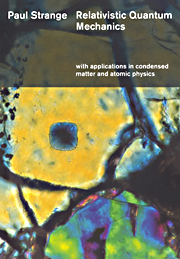Book contents
- Frontmatter
- Contents
- Preface
- 1 The Theory of Special Relativity
- 2 Aspects of Angular Momentum
- 3 Particles of Spin Zero
- 4 The Dirac Equation
- 5 Free Particles/Antiparticles
- 6 Symmetries and Operators
- 7 Separating Particles from Antiparticles
- 8 One-Electron Atoms
- 9 Potential Problems
- 10 More Than One Electron
- 11 Scattering Theory
- 12 Electrons and Photons
- 13 Superconductivity
- Appendix A The Uncertainty Principle
- Appendix B The Confluent Hypergeometric Function
- Appendix C Spherical Harmonics
- Appendix D Unit Systems
- Appendix E Fundamental Constants
- References
- Index
5 - Free Particles/Antiparticles
Published online by Cambridge University Press: 11 January 2010
- Frontmatter
- Contents
- Preface
- 1 The Theory of Special Relativity
- 2 Aspects of Angular Momentum
- 3 Particles of Spin Zero
- 4 The Dirac Equation
- 5 Free Particles/Antiparticles
- 6 Symmetries and Operators
- 7 Separating Particles from Antiparticles
- 8 One-Electron Atoms
- 9 Potential Problems
- 10 More Than One Electron
- 11 Scattering Theory
- 12 Electrons and Photons
- 13 Superconductivity
- Appendix A The Uncertainty Principle
- Appendix B The Confluent Hypergeometric Function
- Appendix C Spherical Harmonics
- Appendix D Unit Systems
- Appendix E Fundamental Constants
- References
- Index
Summary
As in non-relativistic quantum theory, the simplest problem to solve in relativistic quantum theory is that of describing a free particle. Much can be learned from this case which will be of use in interpreting the topics covered in later chapters. Furthermore, some of the most profound features of relativistic quantum theory are well illustrated by the free particle, so it is a very instructive problem to consider in detail. Another advantage of the free-particle problem is that the mathematics involved in solving it is not nearly as involved as that necessary for solving problems involving particles under the influence of potentials.
Firstly we shall look briefly at the formulae for the current and probability density, then we shall go on to examine the solutions of the Dirac equation and investigate their behaviour. This leads us to a discussion of spin, the Pauli limit, and the relativistic spin operator. Next we consider the negative energy solutions and show how relativistic quantum theory predicts the existence of antiparticles. Some of the dilemmas this concept introduces and their resolution are discussed. At the end of the chapter we go back to the Klein paradox, and examine it for an incident spin-1/2 particle. We find that the Klein paradox exists for Dirac particles in exactly the same way as it existed for Klein—Gordon particles and has the same resolution and interpretation.
- Type
- Chapter
- Information
- Relativistic Quantum MechanicsWith Applications in Condensed Matter and Atomic Physics, pp. 130 - 156Publisher: Cambridge University PressPrint publication year: 1998



